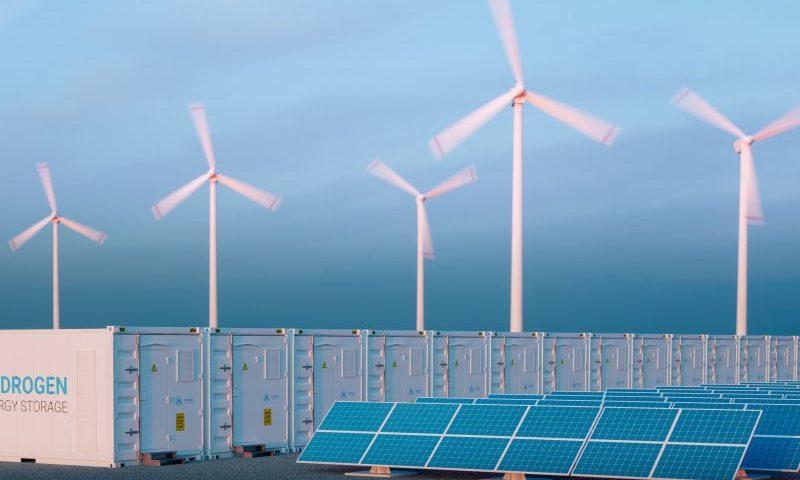Hydrogen is the most abundant chemical element on Earth and is stored in water, natural gas, and organic matter. As an energy carrier, hydrogen has unique properties that make it well suited for large-scale energy storage. It can store excess electricity from renewable resources like solar and wind and be converted back into electricity when needed, reducing waste and increasing renewable energy utilization.
Methods of Hydrogen Production
There are a few main methods for producing hydrogen:
Steam Methane Reforming: This process involves producing hydrogen by reacting natural gas with high-temperature steam. While it is the most common production method today, it results in significant carbon emissions.
Electrolysis: Using electricity to split water into hydrogen and oxygen through an electrolyzer results in zero direct emissions. Electrolysis is a promising renewable hydrogen production method as the electricity can come from sources like solar and wind. Research is focused on making electrolyzers more efficient and cost-effective.
Biomass Gasification: Certain plants and organic waste can be processed at high temperatures with limited oxygen to produce syngas, a mixture of carbon monoxide and hydrogen. The hydrogen is then separated out. This production pathway can utilize waste biomass.
Hydrogen Storage Methods
Pressurized Gas Storage: H2 can be stored in compressed gas at pressures up to 10,000 PSI in high-pressure gas cylinders or tanks. It provides high energy density storage but requires energy-intensive compression.
Liquefied Hydrogen Storage: Upon liquefaction through refrigeration to -253°C, H2 doubles in density. It is stored in well-insulated cryogenic tanks. While energy-dense, liquefaction is an energy-intensive process requiring cryogenic facilities.
Metal Hydride Storage: Certain metal alloys can reversibly absorb and desorb hydrogen, providing solid-state storage. Research focuses on improving gravimetric and volumetric densities.
Chemical Hydrogen Storage: Hydrogen Energy Storage can be bound into liquid organic compounds like methanol through catalytic processes then later released through thermal decomposition. However, energy losses occur during these reversible chemical reactions.
Applications of Hydrogen Energy Storage
Power-to-Gas Conversion: Electrolyzers convert excess electricity from the grid into hydrogen that is injected and stored in the natural gas network or used to produce methane. This allows renewable energy to be stored on a large scale for power generation or industrial/residential end uses when renewable energy output is low.
Industrial Feedstock: Hydrogen is widely used as an industrial feedstock for producing ammonia for fertilizers and processing oils into fuels. Renewable hydrogen produced from electrolysis offers a low-carbon substitute to reduce industrial emissions.
Transportation Fuel: Fuel cell vehicles powered by hydrogen offer a low-emission alternative to electric vehicles where battery limitations exist, such as long-haul trucks, trains, and ships. Widespread use requires a supply and refueling infrastructure, but pilots are emerging in Europe and Asia.
Power Generation: Hydrogen can be burned in modified gas turbines for power generation or used in fuel cells which offer higher efficiencies than combustion. This provides backup energy when renewable generation is low. Fuel cells also have applications as emergency power sources.
Challenges and Potential Solutions
Cost Reduction: Mass production coupled with learning-by-doing can help lower the costs of key hydrogen technologies like electrolyzers, fuel cells, and components. Initiatives aim to achieve cost-competitive renewable H2 by 2030.
Infrastructure Development: Strategic investments are needed to build the supply chains, pipelines, storage facilities, and refueling stations required to deliver hydrogen at scale, especially for transport end uses. Partnerships between industry and governments will be important.
Safe Transport and Handling: Robust safety standards and protocols must be put in place as the handling of hydrogen poses different challenges than liquid fuels due to its volatility. Research continues to improve storage materials and leak-detection systems.
Sustainability Standards: Mechanisms will be required to certify renewable or low-carbon hydrogen production pathways and ensure that emissions reductions are realized across the supply chain from well-to-wheels. International standards organizations are developing frameworks.
As the costs of renewable energy and electrolyzers fall, hydrogen is poised to play a key role in cost-effectively enabling a zero-carbon energy system. By storing energy from solar, wind, and other renewables in the form of hydrogen, intermittent resources can be dispatchable. Diverse end uses covering electricity, heat, industry, and transport mean hydrogen can facilitate deep decarbonization across multiple sectors simultaneously. With coordinated efforts to address challenges, a growing renewable hydrogen economy offers great potential to accelerate the clean energy transition globally.
